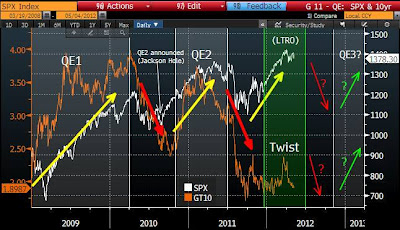
A friend sends me the following chart to support his conclusion that another round of QE is coming from the Fed sometime in June. The chart tracks the ten-year bond and the performance of the S&P since 2009.

Some thoughts on the info provided in this graph:
+While both QE1 & 2 were ending, the S&P fell.
+Operation Twist appears to have successfully restrained any increase in long-term interest rates.
+The European Long Term Financing Operation (LTRO) liquidity operations had a significant positive impact on US equity prices.
+As of today, the spread between LT interest rates and the S&P is the widest it has been in three and a half years.
+ The current level of the ten-year bond is the same as it was during the height of the recession/depression during the 1Q of 2009.
My observations:
– Tyler Durden at Zero Hedge (among others) has been pounding the table with the thesis that what drives markets today is not the size of the Central Bank balance sheets, it is the daily/weekly flow of additional monetary easing that matters. I think the chart confirms this.
– Twist and LTRO are finished for the time being. Bond yields are reacting to the economic slowdown that comes with the ending of these monetary jolts. Stock markets around the world have flattened out; there is good evidence that an equity market correction is underway.
– The huge gap in the current spread between bonds and stocks is scary. Notice that the orange and white lines have crossed numerous times in the past. If the lines were to cross again, it would imply that either interest rates have to shoot up, or the stock market is looking at a very sizable adjustment. I see little chance for interest rates to move higher in the current environment. This sets up the possibility for an out-sized down move in stocks.
– Everyone (most importantly Bernanke) is aware of the information that is contained in this chart. Bernanke is also aware of Durden’s point: you have to feed the beast every week, and you have to commit to weekly feedings far into the future, or markets will get grumpy.
– The expectation from all directions is that the Fed and the ECB will (once again) rise to the occasion (June is the popular time frame), and when they act, stocks will go “green” again.
– That the market is so convinced that the Fed will bail it out (or prevent any significant decline) allows for the very high spread between stock prices and interest rates that exists today. There is a high degree of complacency in the market. It believes the Fed is the backstop, and it will always be there when markets flutter.
To Read More CLICK HERE












